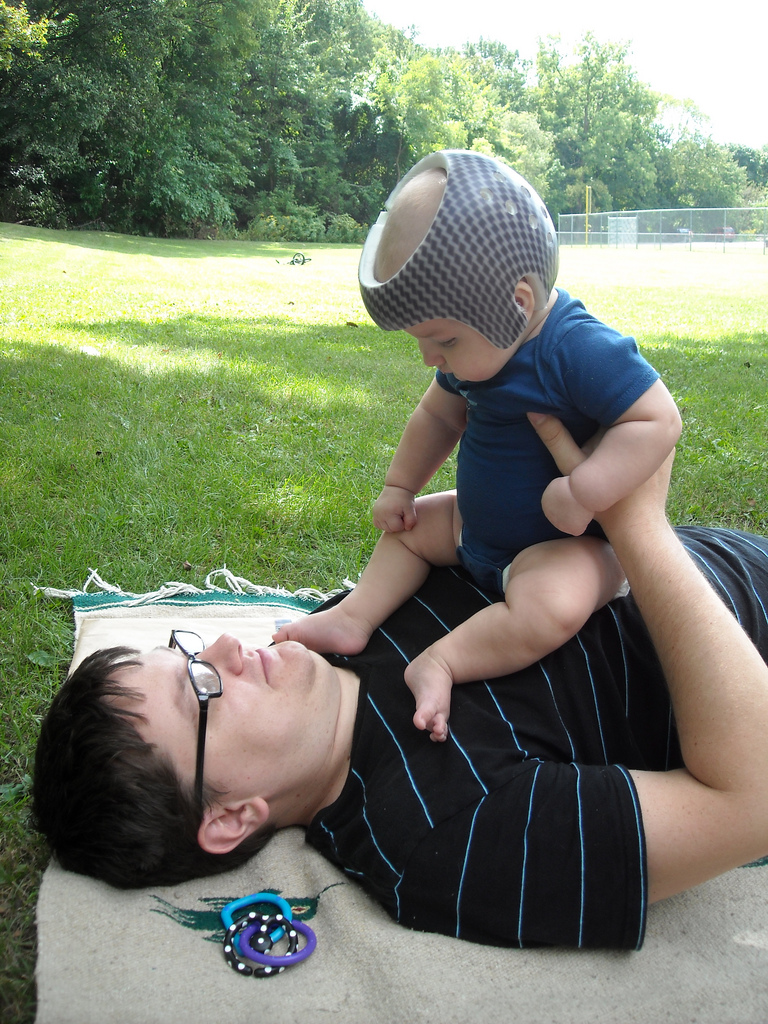Parents sometimes notice asymmetry in the heads of their newborn children. It appears to be “flattened” or a bit crooked, tilted. This feature can be treated and is known as plagiocephaly1, or flat head syndrome. There are mild cases and more severe ones, which may require an orthopedic helmet to correct the formation. Up to the first six months of life, any deformation or change in the growth of the baby’s head can be considered a case of cranial deformation, with plagiocephaly being one of them. For a diagnosis, the doctor must first differentiate plagiocephaly from brachycephaly2 and scaphocephaly3, which are quite similar, but plagiocephaly only deforms one side of the head. Sometimes, exams such as X-rays, CT scans, or MRI are prescribed, but generally they are not needed to recognize plagiocephaly; visual inspection and measurement with a craniometer are usually sufficient. Plagiocephaly can be classified into three levels, depending on the difference in the angle measurements of the two longest diagonals of the baby’s head. In cases without asymmetry, these diagonals form equal angles. When there is a difference, it can be calculated as follows:
| Diagnosis | Asymmetry |
|---|---|
| Mild plagiocephaly | Up to 9 mm |
| Moderate plagiocephaly | 10 to 19 mm |
| Severe plagiocephaly | More than 20 mm |
Causes of Plagiocephaly
Positional plagiocephaly (PP), unlike other cranial shape anomalies, is caused by external factors to the baby’s body: for example, the baby’s position in the uterus during pregnancy. When the developing child stays too long on one side, or in the same position inside the mother’s belly, this can result in congenital torticollis and positional plagiocephaly. Also, after birth, if the baby does not move much and spends a lot of time lying down, he or she may develop what is also called postural plagiocephaly. This happens because the baby’s skull bones are not yet fully formed and have movable plates, called sutures. Therefore, pressure from the mattress or pillow on the head can cause these plates to flatten, especially at the back (anterior plagiocephaly) or on one of the sides. As there is also not enough neck strength to support the head, all its weight goes directly to the point of contact with the mattress, causing the deformation. Because of these causes of plagiocephaly, it can regress spontaneously if pressure on the affected area does not continue.
Risk Factors
It is also proven that the majority of cases occur in male babies. Some other associated conditions, such as craniosynostosis, preterm births, and other risk factors may be linked to the cause of plagiocephaly. Check the table with the main Risk Factors:
| Pre- and perinatal | Postnatal |
|---|---|
|
|
An interesting fact is that, after the American Academy of Pediatrics recommended that parents put their children to sleep on their back (supine position) to prevent Sudden Infant Death Syndrome, there was, on the other hand, an increase in plagiocephaly among American babies, now affecting up to 13% of newborns. In Brazil, studies are still being conducted. However, since plagiocephaly is not as serious as the risk of sudden death, it is still more recommended that babies sleep on their backs, and that other treatment measures be adopted.
Recommendations to Prevent and Treat Plagiocephaly
Concern about plagiocephaly is important because it causes deformities, and, especially if the problem is detected early (in the first month, or even in the maternity ward), it can be reversed in a simple way. Doctors recommend starting physiotherapy measures up to six months of the child’s age, when there is the best chance for a positive treatment result. However, until 18 months or, at most, two years, the skull may still be forming (this time may vary) and it is possible that interventions and changes in habits can have some effect. The solution can be simple: changing the baby’s positioning while awake can help, such as encouraging tummy time for 15 to 20 minutes, four times a day. Moving the baby’s crib weekly is also recommended for plagiocephaly, since the baby’s preferred positions and the direction of his gaze may be influenced by the layout of objects in the room, or the mother’s position in relation to the crib.
IMPORTANT: The baby should be supervised during tummy time and should never sleep in this position as there is a risk of suffocation and sudden death.
Other repositioning tips include avoiding leaving the child too long in a car seat or stroller and varying the way the baby is held in your arms, especially during breastfeeding. There is already a pillow tested and recognized by pediatricians, pediatric neurosurgeons, and pediatric physical therapists that helps support the baby’s skull in situations where he or she spends a long time lying down, such as during trips. In more severe cases of plagiocephaly, the use of a “cranial orthosis”, which is a type of orthopedic helmet as shown in the image below, may be necessary. 











